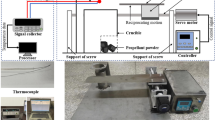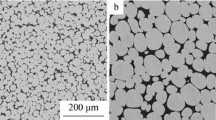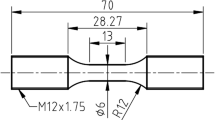Abstract
Experimental results are presented on the changes in mechanical properties of HASTELLOY X* after being used in the liner tube of HENDEL hot gas duct under high temperature helium gas for about 6000 hours. In both room and elevated-temperature tensile tests, 0.2 pct proof stress and total elongation were significantly decreased after exposure in high temperature helium. Room-temperature impact toughness of the exposed specimens exhibited a much lower absorbed energy (about 5.0 × 106 J/m2) than that of unexposed specimens (about 1.5 × 106 J/m2). The fracture modes of tensile test specimens were more closely correlated with the test temperature than with the long-time exposure; however, long-time exposure is more affected by the tensile strength of HASTELLOY X than the test temperature. Moreover, “downstream effect” for the carbide precipitation reaction occurred in the liner tube of the HENDEL hot gas duct.
Similar content being viewed by others
References
H. Nickel, P. J. Ennis, F. Schubert, and H. Schuster:Nucl. Technol., 1982, vol. 58, pp. 90–98.
T. Kondo: Proc. Conf. Gas-Cooled Reactors Today, Bristol, England, Sep. 20–24, 1982, No. 95, British Nuclear Society, 1983.
M. Shindo and T. Kondo:Tetsu-to-Hagané, 1976, vol. 26, pp. 1540–47.
M. Shindo and T. Kondo: Proc. Conf. Gas-Cooled Reactors Today, Bristol, England, Sep. 20–24, 1982, No. 97, British Nuclear Energy Society, 1983.
R. A. Huddle: Proc. Conf. High Temperature Reactor and Process Applications, London, Nov. 26–28, 1974, Session VI, British Nuclear Energy Society, 1974.
H. Inoue:Nucl. Technol., 1984, vol. 66, pp. 392–403.
T. Kondo, Y. Ogawa, and K. Watanabe :JAERI-memo 6610, 1976, pp. 147–217.
C. C. Li, W. R. Johnson, and L. D. Thompson:Nucl. Technol., 1984, vol. 66, pp. 439–64.
M. Hishida, K. Kunitomi, I. Ioka, and Y. Kondo:Journal of the Atomic Energy Society of Japan, 1984, vol. 26, pp. 506–18.
M.A. Arkoosh and N. F. Fiore:Metall. Trans., 1972, vol. 3, pp. 2235–40.
G. Y. Lay:Metall. Trans. A, 1978, vol. 9A, pp. 827–33.
Author information
Authors and Affiliations
Additional information
HASTELLOY is a trademark of Cabot Corporation.
Rights and permissions
About this article
Cite this article
Kondo, Y., Fukaya, K., Kunitomi, K. et al. Tensile and impact properties changes of HASTELLOY X after exposure in high-temperature helium environment. Metall Trans A 19, 1269–1275 (1988). https://doi.org/10.1007/BF02662588
Received:
Issue Date:
DOI: https://doi.org/10.1007/BF02662588




